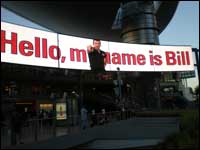When I was in high school, in my sleepy, remote hometown, the local shopping mall wanted to do something different for the holiday shopping season. Not content with a mere Santa Claus, they had plans to build and “populate” a talking Christmas tree.
This hollow tree would contain a person — someone who would sit there all day and accost passersby, engaging them in clever yuletide banter. I must have gotten a reputation as someone who you couldn’t shut up, because I was offered the gig.
I declined.
I was 13 years old, and acutely aware that as soon as word got out I was the voice behind this blight on the retail landscape, I would become a serious candidate for after-school deforestation.
Everyone knows that mascots are not cool.
I must have given off a serious death wish, because I got a similar offer when I was in college. I was working as an intern at a bank.
They were shocked and crestfallen when I told them no, I would not spend my weekends prancing through the aisles of our football stadium dressed as a giant foam checkbook. What could I be thinking? I’ll tell you what I was thinking: Mascots are not cool.
 That’s why I took special note when I heard this account on NPR’s On The Media. It’s of a mascot that is actually, certifiably cool. The podcast segment includes an interview with the actor who brings this mascot to life. And yes, he fully grasps that he has landed a truly plum job.
That’s why I took special note when I heard this account on NPR’s On The Media. It’s of a mascot that is actually, certifiably cool. The podcast segment includes an interview with the actor who brings this mascot to life. And yes, he fully grasps that he has landed a truly plum job.
He’s the star of an animated, digital billboard in Las Vegas. Hidden cameras and microphones allow him to carry on conversations with pedestrians, while images of the products and services he’s hawking stream and flash in the background.
I’m still trying to fathom why this is so dramatically different from a talking Christmas tree in Escanaba, Michigan. I’ve concluded that it’s another example of The Age of the Nerd.
If it’s digital, it is most likely pretty awesome.
So, if the marketing department of that bank where I interned is reading this, I have something to say to you:
I’m a little long in the tooth to sell checking accounts in football stadiums, but if the offer still stands, I’m your man, on one condition: It’s got to be electronic checking.
 That’s why I took special note when I heard
That’s why I took special note when I heard